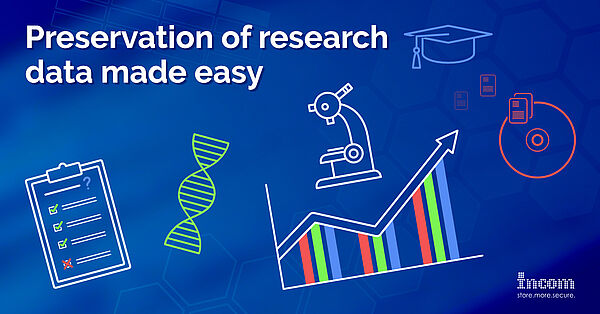Specific compliance applies in the area of research and teaching, which universities, institutions and research funders such as the German Research Foundation (DFG) are increasingly emphasising. This is also happening against the backdrop of increasing data growth and analysis possibilities. The requirements for sustainable data protection and reliable data archiving are increasing. A well thought-out and resilient concept for research data management is considered a natural part of a project design. Research data and measurement data are therefore an increasingly valuable raw material, as they are often reused for new evaluations even years or decades later. How the data is stored is usually up to the researchers themselves, and often analogue information (questionnaires, interview notes, etc.) must first be digitised in order to be able to evaluate it by machine at all.
But how do you properly archive digital data?
External hard disks or the popular USB sticks offer neither security nor are the data stored on them safe from manipulation and can only be reliably stored for a limited period of up to 5 years. The best prerequisites for long-term and unchangeable data storage are still offered by optical data carriers. Drives and media are available from many manufacturers, offer a sufficiently high capacity for archiving in the research environment and, above all, cross-generational compatibility, because even the first CDs can still be read today (30 years later) with any commercially available drive.
What is still manageable on a small scale with individual data carriers naturally reaches its limits in the university environment. This is where large libraries come into play, which can offer and manage storage capacity in the petabyte range. For users and applications, the intelligent storage system provides a file share into which data can be written directly and transparently, and from which data can also be read again. In the background, the data is then written to the Blu-ray media, which are catalogued by the system in a database. Should this database ever be damaged, the media can be automatically reinventoried so that no information is lost.
Funding for projects especially for the long-term provision and reusability of research data is already possible for the projects and beyond. Additional requirements are made and information on the further use or exploitation of the data after the end of the project is desired. The research data should be accessible in a processing stage (raw data or already further structured data) that enables a meaningful subsequent and further use by third parties. The use of long-term optical storage systems in particular also ensures that all data can be found, accessed, interoperated and reused, thus meeting the requirements of the European Commission's FAIR principles.
Another aspect far removed from durability is the ecological footprint of the archiving method, because once stored, these data carriers do not consume electricity. Even the large libraries with capacities up to the petabyte range only come to a few hundred watts under full load, unlike the ever-spinning hard disk systems, which also emit heat that has to be cooled down in the data centres at great energy expense.
INCOM has been offering its archive systems for more than 25 years. Users are e.g. banks and insurance companies, but also many industrial customers or universities, institutes and hospitals. In the last 3 years alone, INCOM has implemented optical storage systems with an archive volume of 25 petabytes in system environments.
